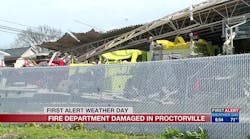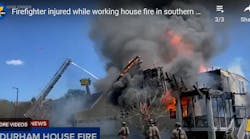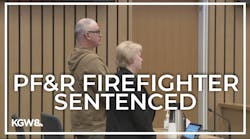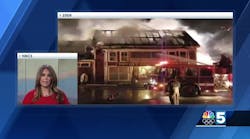May 05--The new Albuquerque Fire Department chief is on the frontlines of a new era of metropolitan firefighting, one that emphasizes preventative health care in the age of the Affordable Care Act and recognizes that firefighters' public safety role is becoming much more proactive.
If everything goes as planned, firefighters in Albuquerque will see fewer and fewer calls for emergency services, and they will take fewer patients to Albuquerque emergency rooms.
AFD Chief David Downey said the department is now focusing on identifying emergency-room alternatives and preventing hazards for the elderly and chronic alcohol and drug abusers, and he said he's considering instituting a program, which exists elsewhere, of sending a firefighter and a social worker to the homes of those recently discharged from the hospital to follow up and check in.
The chief, who took over the department in March, said the Affordable Care Act, also known as Obama-care, has escalated a national conversation about the role of public safety professionals in not only responding to but also preventing emergency medical calls.
Meanwhile, the number of actual fires AFD has responded to has decreased over the decades, thanks, in part, to improved building codes, sprinkler systems and other fire-prevention innovations.
"Every fire conference you go to, that is one of the more highly attended forums: EMS prevention and the Affordable Care Act, and what that means to the fire service," Downey said in a recent interview. "The whole fire service is still trying to figure that out to what our niche is."
The number of fires the department responded to has decreased by one-third in less than a decade, from 6,964 in 2006 to 4,676 in 2013, according to data provided by AFD. The trend is echoed nationally, with around 2.3 million fires reported in 1986 and fewer than 1.4 million in 2012, according to the National Fire Protection Association.
In that same time period, the number of medical calls firefighters responded to nationally has nearly tripled, from 6.4 million in 1986 to 21.7 million in 2012.
Though AFD's emergency medical call numbers since 2006 showed no such increase, Downey said emergency medicine is becoming a larger part of the department's mission as Albuquerque's population ages and continues to tax the health care system.
"In the last 40 years, the number of fires has gone dramatically down. As that's happened, the fire service has had to change its identity as certain needs arose," Downey said. "... We tend to always find another niche in terms of hazards, emergency response, which is good because, if all we did was fight fires, there's just not enough of that business."
The department is now beginning to outfit more of its fire engines with "advanced life support" resources, including defibrillators and IV kits, and will increase the number of paramedics on its firetrucks from 42 to 20. It is also, along with Albuquerque police, referring those with drug or alcohol problems to Metropolitan Assessment and Treatment Services, which provides detox and offers therapy options for so-called "chronic inebriates."
Downey said he is also considering instituting a program, which exists in other places, of sending a firefighter and a social worker to homes of people who have been released from the hospital. There, they would be able to ensure the person is taking their medications properly and avoiding fire and other types of hazards -- all in the hopes of reducing unnecessary emergency room visits, a staple of the March 2010 health care overhaul.
According to the 2010 census, the city is anticipating a sharp increase in the number of elderly residents. With that, Downey said, is an associated increase in emergency medicine calls, and he said the department will now focus on identifying hazards afflicting the elderly population to avoid unneeded injuries and costs. He said it's the new role of the fire department to engage in what he called "community paramedicine," rather than the continued "reactive" approach of sending a firetruck to every medical call and dumping patients at the emergency room for what are often preventable conditions.
"We're becoming one of those retirement communities. We have pretty nice climate here, and we see our elderly population growing," he said. "I guess it grew quite a bit from 2000 and 2010 and what they see happening between 2010 and 2030 census is we're going to have a much higher elderly population in terms of the entire percentage with our community. ... We see it. That's the future. We know it's coming."
The fire chief stressed that this new push for community-based preventative care does not mean that the fire department is not needed or that its firefighting mission is irrelevant, just that the department will have to adapt to a variety of new roles.
"There's still going to be fires, there's still going to be car accidents, there's still going be cardiac arrests. Those aren't going away," Downey said. "But as the number of calls continues to increase, we can either continue to just keep sending the firefighters and the firetrucks and just keep adding the same mechanism to treat the problem, or get on the prevention side of it."
In addition to anticipating needs of the elderly, the department is also hoping to expand alternatives for chronic alcohol and drug abusers. In the past, when the fire department arrived to city sidewalks or alleys in response to a person incapacitated due to drug and alcohol abuse, firefighters or EMTs would do a "shake and shout" to determine the person's level of coherence and, if they could not walk away under their own power, they'd be on their way to the hospital, Downey said.
"The amount of resources and man hours and the cost associated with that call, when it wasn't an acute emergency and just someone who was sleeping it off, quite honestly ... for years that meant they went to the hospital. Now it's about let's find another resource for you."
In April 2013, the city began the Public Inebriate Prevention Program, which refers so-called "chronic inebriates" to the county's Metropolitan Assessment Treatment Services building. Each stage of the program is voluntary, including getting into the "PIIP van" in the first place.
Of the more than 1,500 referrals made to MATS by the PIIP between April 6, 2013, and March 31, 2014, just 8.1 percent of people refused the transport, according to data provided by AFD, and fewer than 10 percent were sent to the hospital. The number of referrals means less backup at the emergency room and less-crowded jail cells.
Downey said that, in keeping with the city's public safety and health care officials' push toward prevention and emergency-room alternatives, he'd like to see PIIP made its own unit with its own source of funding and additional resources. At the moment, the PIIP van, which is driven by an Albuquerque police officer and a firefighter, roams Albuquerque streets just four days a week from mid-afternoon to late-evening.
"It's made a difference," Downey said. "It's a program we would really like to expand."
Copyright 2014 - Albuquerque Journal, N.M.





